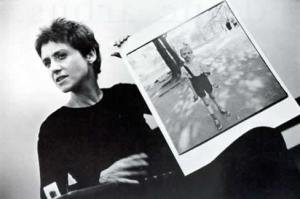 The subtitle for the new biopic "Fur," starring Nicole Kidman, is "An imaginary portrait of Diane Arbus." Negative reviews have mostly focused on the fact that Arbus' body of work in photography was all about unsentimental realism, though they also note that the submissive approach of Kidman's character to her work is clearly inaccurate and that Kidman herself does not look remotely like Arbus ever did. With so much of the imaginary, there is little of Arbus in the film's portrait.
The subtitle for the new biopic "Fur," starring Nicole Kidman, is "An imaginary portrait of Diane Arbus." Negative reviews have mostly focused on the fact that Arbus' body of work in photography was all about unsentimental realism, though they also note that the submissive approach of Kidman's character to her work is clearly inaccurate and that Kidman herself does not look remotely like Arbus ever did. With so much of the imaginary, there is little of Arbus in the film's portrait.Arbus, who committed suicide in 1971 at the age of 48, was best known for her photography of society's "freaks": transvestites, giants, dwarfs, nudists, prostitutes, and institutionalized developmentally disabled folks. That's the disability connection. Arbus captured images of disabled people or those with abnormal appearance (which is often associated with disability). Her relationship to the people she photographed has long been a subject of debate. What exactly was her personal fascination with these people about? Was she exploiting her subjects or lovingly documenting their lives? What effect does the power of the photographic gaze have when turned on the powerless or disenfranchised in society? What impact, specifically, does Arbus' stark unsentimental style have on this power of the gaze?
 Slate's Dana Stevens' review of "Fur," ironically subtitled "A Lame Take on Photographer Diane Arbus," finds the film stylistically inaccurate to Arbus' life and work:
Slate's Dana Stevens' review of "Fur," ironically subtitled "A Lame Take on Photographer Diane Arbus," finds the film stylistically inaccurate to Arbus' life and work: I'll just note, by way of observation, that the movie's style and mood are the opposite of Arbus' own starkly unsentimental work. Everything in the movie is laboriously pretty. The general atmosphere is Gothic in the style of Twin Peaks: Fetishized freaks are tossed here and there for accent, like throw pillows, while a relentless score by Carter Burwell keeps reminding us how to feel about each moment: Spooked! Tender! Erotically transported!Similarly, from the NYT:
In “Fur,” Mr. Shainberg’s screenwriter, Erin Cressida Wilson, who also wrote “Secretary,” twists the classic Freudian concept of sexual fetishism, having apparently decided that the best way to explain Arbus’s singular perspective on the world is to transform her into a fetishist. Thus, in this formulation, Lionel, her fuzzy neighbor, becomes a kind of walking, talking fetish, a means — to freedom, creativity, imagination and what Ms. Bosworth calls the dark world — that will usher her into a new realm. This sounds more promising than what materializes on screen largely because Mr. Shainberg and Ms. Wilson have turned Arbus’s life into a neurotic fairy tale.The fictional fur-covered Lionel introduces Kidman's character to freaks through erotic seduction and controls the submissive film-Arbus' access of them. So, in addition to casting Arbus' subjects as interesting only through fetishism and not for their distinctive humanity, Arbus herself is denied control of her own artistry. Again, Stevens in Slate:
....The script's subtle misogyny, which relegates Arbus' work to the realm of personal liberation, tries to pass itself off as feminism. As the film re-imagines Arbus' career, she begins to take pictures only when given permission to explore her dark side by the wounded Lionel. The problem with this vision of the real Arbus' life isn't that it's myth; it's that it's crap. In the film, art is, in the end, something Arbus makes to please her cool new boyfriend, a kind of mix tape on photographic paper. Even her choice of subject matter to photograph—the castoffs of society, giants, freaks, and amputees—doesn't come from Arbus' own deliberative process. These just happen to be the people in her sweetie's peer group, and after all, they are pretty punk-rock looking, what with the armlessness and all.From Mia Fineman, also in Slate:
The problem with this scenario as an expression of Arbus' "inner experience" is that it divests her of any artistic agency. Arbus, who in reality was fiercely intelligent and articulate about her chosen art form, comes off as a benighted ingénue—not so much an artist as an adventurous '50s housewife in the process of discovering her bohemian side.The director defends the film's twisted vision of Arbus in The Washington Post:
"Some of the things people might expect or wish from an Arbus film are so dull to do cinematically," said Shainberg, whose previous film "Secretary" received critical acclaim. "I don't personally want to get in the bathroom with her when she kills herself."While it's interesting to hear a director say suicide is cinematically dull, what's really dull is the culturally dominant take on what "freaks" are all about and an apparently deliberate mistelling of Arbus' approach to her artistic work. The 2003 catalog of her work, as well as the traveling exhibit to accompany it, are both titled "Revelations," but there's nothing revelatory of assigning society's "freaks" the role of object of fetishism or explaining a woman's professional work as inspired by something other than her own original vision.
The photographs above show Arbus with a poster of one of her photographs and Kidman in the role of Arbus, respectively. Arbus is a dark-haired, dark-eyed New York Jew, while Kidman, of course, is her WASP-y Australian self, though her hair seems to have been dyed for the role.
0 comments:
Post a Comment